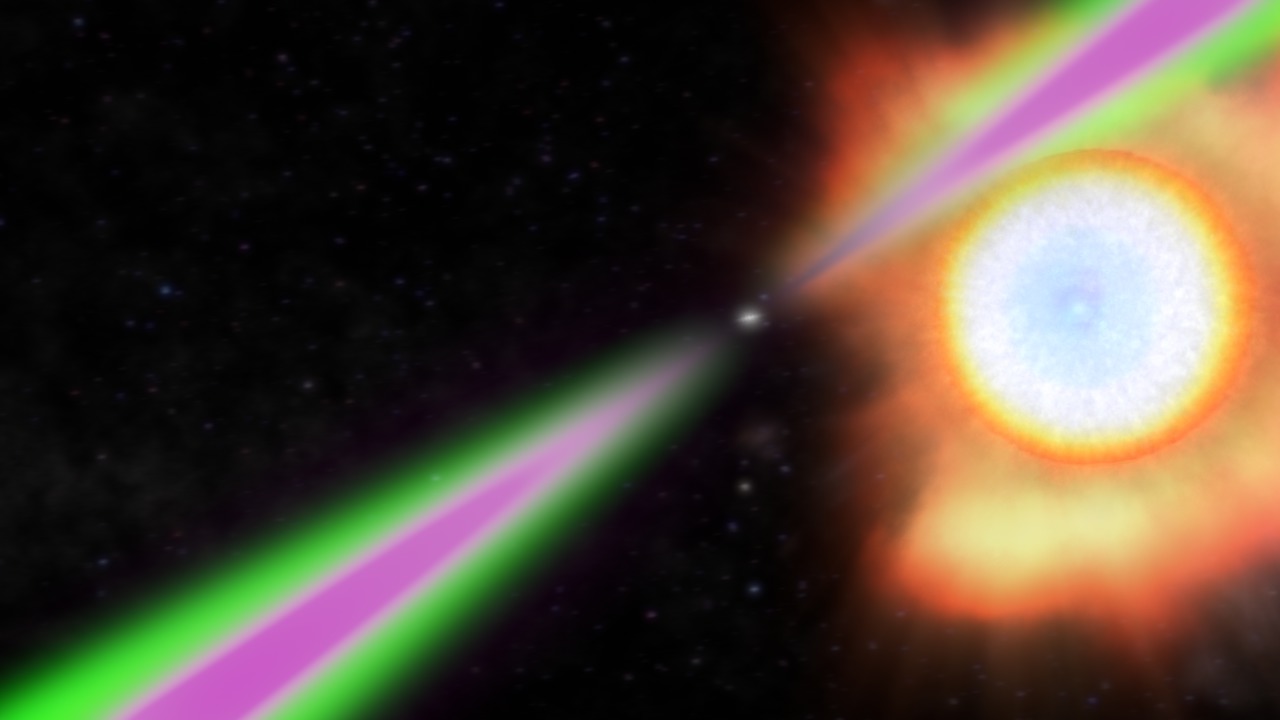PSR J1311-3430 'Black Widow' Pulsar Animations
The essential features of black widow binaries, and their cousins, known as redbacks, are that they place a normal but very low-mass star in close proximity to a millisecond pulsar, which has disastrous consequences for the star. Black widow systems contain stars that are both physically smaller and of much lower mass than those found in redbacks.
So far, astronomers have found at least 18 black widows and nine redbacks within the Milky Way, and additional members of each class have been discovered within the dense globular star clusters that orbit our galaxy.
These animations show artist's impressions of one system, named PSR J1311-3430. Discovered in 2012, J1311 sets the record for the tightest orbit of its class and contains one of the heaviest neutron stars known. The pulsar's featherweight companion, which is only a dozen or so times the mass of Jupiter and just 60 percent of its size, completes an orbit every 93 minutes – less time than it takes to watch most movies. Recent studies allow a range of values extending down to 2 solar masses for the pulsar, still among the highest-known for neutron stars.
This view shows J1311 as we see it from Earth. The pulsar's gamma-ray emission (magenta) dominates from our perspective because our line of sight passes through dense clouds of ionized gas blown off of the companion star. Most of the time, these clouds are dense enough to either absorb or scatter the pulsar's radio signals (green), preventing their detection. The pulsar's rotation — in reality, 23,000 rpm — has been slowed for clarity.
Slower version of the above animation.
This view shows J1311 from above its orbital plane, a view not accessible from Earth. Gas blown off the companion star trails along its orbit and diffuses throughout the system but is densest along their orbital plane. From this vantage point, both the radio beam (green) and the gamma-ray emission (magenta) escape the system. The pulsar actually spins 390 times each second.
Slower version of the above animation.
The black widow pulsar J1311 and its small stellar companion, viewed within their orbital plane. Powerful radiation and the pulsar's "wind" – an outflow of high-energy particles — strongly heat the facing side of the star to temperatures twice as hot as the sun's surface. The pulsar is gradually evaporating its partner, which fills the system with ionized gas and prevents astronomers from detecting the pulsar's radio beam most of the time. The star's surface is also distorted by the gravitational pull of the more massive pulsar.
Slower version of the above animation.
Credits
Please give credit for this item to:
NASA's Goddard Space Flight Center/Cruz deWilde
-
Animator
- Cruz deWilde (Avant Gravity)
-
Producer
- Scott Wiessinger (USRA)
-
Scientist
- Roger Romani (Stanford University)
-
Writer
- Francis Reddy (Syneren Technologies)
Release date
This page was originally published on Thursday, February 20, 2014.
This page was last updated on Wednesday, May 3, 2023 at 1:51 PM EDT.
Missions
This visualization is related to the following missions:Series
This visualization can be found in the following series:Tapes
This visualization originally appeared on the following tapes:-
Fermi Black Widow Pulsar
(ID: 2013004)
Tuesday, November 26, 2013 at 5:00AM
Produced by - Robert Crippen (NASA)
